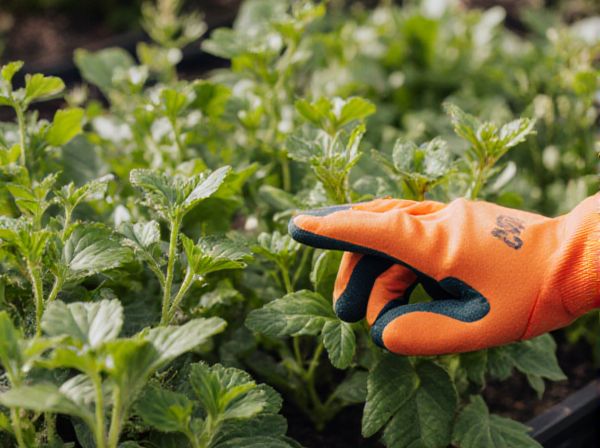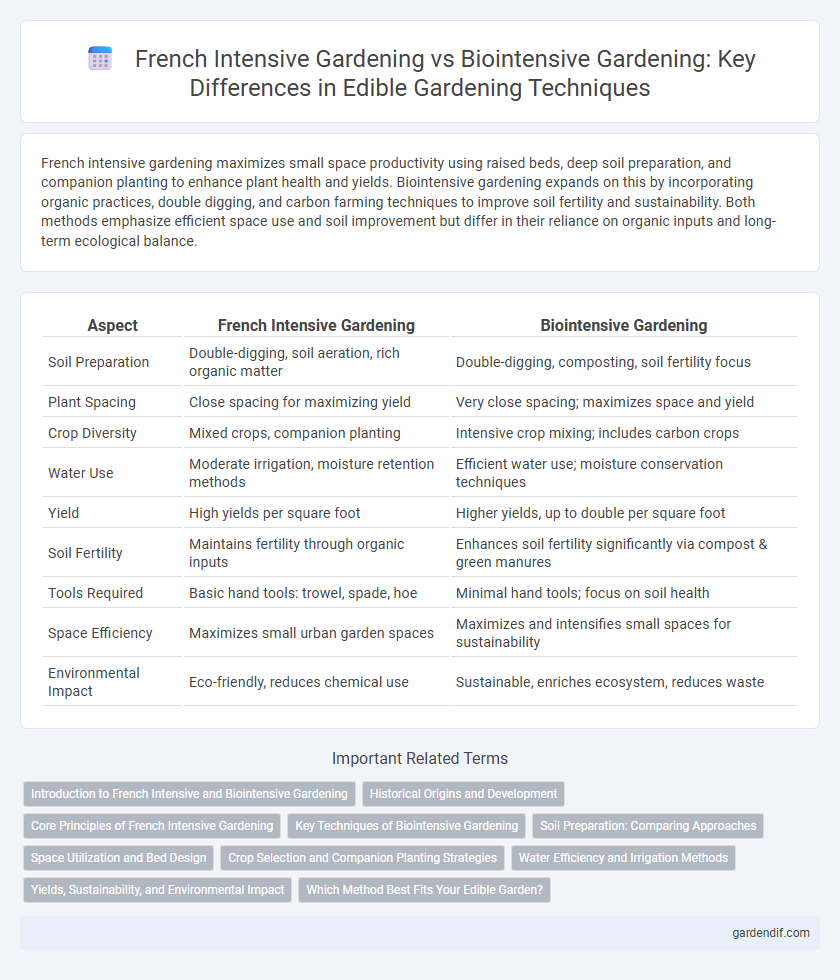
French intensive gardening vs Biointensive gardening Illustration
French intensive gardening maximizes small space productivity using raised beds, deep soil preparation, and companion planting to enhance plant health and yields. Biointensive gardening expands on this by incorporating organic practices, double digging, and carbon farming techniques to improve soil fertility and sustainability. Both methods emphasize efficient space use and soil improvement but differ in their reliance on organic inputs and long-term ecological balance.
Table of Comparison
| Aspect | French Intensive Gardening | Biointensive Gardening |
|---|---|---|
| Soil Preparation | Double-digging, soil aeration, rich organic matter | Double-digging, composting, soil fertility focus |
| Plant Spacing | Close spacing for maximizing yield | Very close spacing; maximizes space and yield |
| Crop Diversity | Mixed crops, companion planting | Intensive crop mixing; includes carbon crops |
| Water Use | Moderate irrigation, moisture retention methods | Efficient water use; moisture conservation techniques |
| Yield | High yields per square foot | Higher yields, up to double per square foot |
| Soil Fertility | Maintains fertility through organic inputs | Enhances soil fertility significantly via compost & green manures |
| Tools Required | Basic hand tools: trowel, spade, hoe | Minimal hand tools; focus on soil health |
| Space Efficiency | Maximizes small urban garden spaces | Maximizes and intensifies small spaces for sustainability |
| Environmental Impact | Eco-friendly, reduces chemical use | Sustainable, enriches ecosystem, reduces waste |
Introduction to French Intensive and Biointensive Gardening
French intensive gardening emphasizes high-yield vegetable production on small plots using double-digging techniques, close plant spacing, and organic soil amendments to maximize nutrient availability. Biointensive gardening expands on these principles by integrating heirloom seeds, composting, and companion planting to enhance soil fertility and biodiversity while maintaining ecological balance. Both methods prioritize sustainable, efficient land use aimed at producing abundant, nutrient-dense crops with minimal environmental impact.
Historical Origins and Development
French intensive gardening originated in 19th-century France with market gardeners aiming to maximize yield on small urban plots using deep soil preparation and close plant spacing. Biointensive gardening, developed in the 20th century by John Jeavons in California, built upon French intensive principles by emphasizing composting, open-pollinated seeds, and sustainable soil fertility for long-term productivity. Both methods focus on efficient land use but biointensive integrates ecological practices for enhanced sustainability and soil health.
Core Principles of French Intensive Gardening
French intensive gardening emphasizes deep soil preparation, close plant spacing, and companion planting to maximize yields in small spaces. It relies on raised beds enriched with organic matter to improve soil structure and nutrient availability. This method also integrates crop rotation and succession planting to maintain soil health and optimize productivity throughout the growing season.
Key Techniques of Biointensive Gardening
Biointensive gardening emphasizes deep soil preparation, utilizing double-digging to enhance aeration and root growth, which differs from French intensive methods that focus more on close plant spacing. It incorporates composting to maintain nutrient-rich soil and promotes companion planting to optimize space and pest control. Carbon farming, using crops like carbon-rich grains, is a unique technique in biointensive gardening aimed at improving soil fertility and sustainability.
Soil Preparation: Comparing Approaches
French intensive gardening emphasizes double-digging to improve aeration and drainage, creating deep, loose soil ideal for root growth. Biointensive gardening combines double-digging with compost integration and planting in raised beds, maximizing soil fertility and moisture retention. Both methods prioritize soil structure enhancement but biointensive techniques further boost organic matter content to support sustainable yields.
Space Utilization and Bed Design
French intensive gardening maximizes space by using raised beds with wide pathways and double digging to improve soil aeration, allowing dense planting of diverse crops. Biointensive gardening employs closely spaced, hexagonal planting patterns in double-dug beds enriched with organic matter, optimizing space and promoting higher yields in smaller areas. Both methods emphasize deep soil preparation, but biointensive bed design prioritizes carbon farming and soil sustainability alongside maximized space utilization.
Crop Selection and Companion Planting Strategies
French intensive gardening emphasizes high-density planting with a focus on nutrient-rich, fast-growing crops like leafy greens and root vegetables, optimizing small spaces through strategic companion planting such as pairing lettuce with radishes to maximize growth. Biointensive gardening prioritizes heirloom and open-pollinated varieties, integrating deep soil preparation with companion planting that enhances biodiversity and pest control, for example, planting beans near corn to improve nitrogen fixation. Both methods utilize companion planting to improve crop yields and soil health, but biointensive gardening incorporates a broader ecological approach emphasizing sustainability and organic nutrient cycling.
Water Efficiency and Irrigation Methods
French intensive gardening maximizes water efficiency through deep soil preparation and dense planting, reducing evaporation and promoting moisture retention. Biointensive gardening emphasizes double digging and incorporating organic matter, enhancing soil structure to improve water infiltration and minimize irrigation needs. Both methods utilize targeted drip irrigation or soaker hoses to deliver precise water amounts, supporting sustainable water management in edible gardens.
Yields, Sustainability, and Environmental Impact
French intensive gardening emphasizes maximizing yields through close plant spacing and raised beds, achieving high productivity per square meter with moderate resource input. Biointensive gardening, developed from French intensive methods, further enhances sustainability by emphasizing open-pollinated seeds, composting, and carbon farming, resulting in greater soil health and long-term environmental benefits. Both methods reduce water usage and chemical inputs compared to conventional farming, but biointensive gardening offers superior environmental impact through its holistic approach to ecosystem balance and resource conservation.
Which Method Best Fits Your Edible Garden?
French intensive gardening maximizes yield by closely spaced planting and soil aeration, ideal for small urban plots with limited space. Biointensive gardening emphasizes deep soil preparation, composting, and heirloom seed saving, promoting long-term soil fertility and sustainability for diverse edible crops. Choosing the best method depends on your garden size, soil condition, and commitment to soil health improvement.
French intensive gardening vs Biointensive gardening Infographic

 gardendif.com
gardendif.com